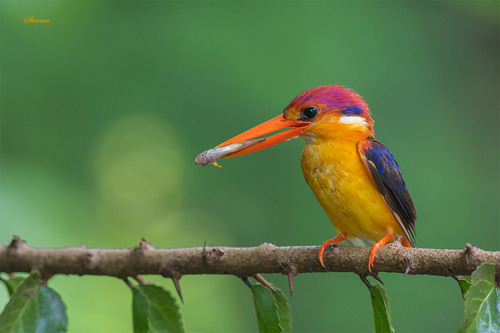
Oriental Dwarf Kingfisher
The Oriental Dwarf Kingfisher, Ceyx erithaca, dazzles with its vivid hues and lightning-fast dives in Southeast Asia's lush forests. This tiny, colorful bird plays a vital ecological role by curbing insect numbers, enchanting observers with its beauty and dynamic presence in dense woodland areas.
4 years
Lifespan
11.3398 - 19.8411 g
Weight
Length: 10 - 15 cm
Size
Red, Blue, Black, White, Orange, Lilac
Color
Near Threatened
Conservation Status
Decreasing
Population Trend
Characteristics
Ceyx erithaca, known as the Oriental Dwarf Kingfisher, inhabits the dense forests of Southeast Asia. This vibrant bird boasts a striking blend of bright orange, yellow, and blue plumage. It is known for its swift, agile flight and distinctive call. Primarily insectivorous, it contributes to controlling insect populations.
Distribution Range of the Oriental Dwarf Kingfisher
Ceyx erithaca, commonly known as the Oriental Dwarf Kingfisher, is native to the tropical and subtropical regions of South and Southeast Asia. Its geographical distribution includes countries such as India, Sri Lanka, Nepal, Bhutan, Bangladesh, Myanmar, Thailand, Malaysia, Indonesia, and the Philippines. The species is predominantly found in the Western Ghats and Eastern Himalayas in India, as well as the Sundaland region which encompasses the Malay Peninsula, Borneo, Sumatra, and Java.
Oriental Dwarf Kingfisher's Habitat
Environmental Conditions
The Oriental Dwarf Kingfisher typically inhabits lowland, evergreen, and deciduous forests. It is often found near streams, small rivers, and ponds within dense, humid forest areas, which provide the necessary cover and food resources. The climate in these habitats is generally tropical, with high humidity and substantial rainfall, especially during the monsoon season.
Ecological Niche
As a small kingfisher species, Ceyx erithaca plays a role in the ecosystem as a predator of small aquatic and terrestrial insects, as well as small vertebrates like frogs and lizards. Its presence indicates a healthy forest ecosystem with adequate water sources. The bird's vibrant plumage and elusive nature make it a key species for birdwatchers and ecotourism in its native range.
Copyright @ Nature Style Limited. All Rights Reserved.
 English
English